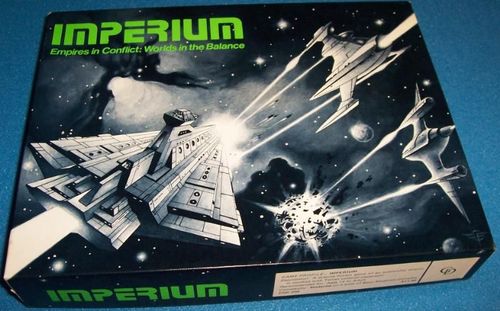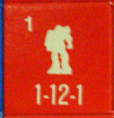
Conflict Games’ interstellar conquest game Imperium has gone through many iterations and revisions, including retroactively being incorporated into Traveller by becoming its default setting. The 1977 1st edition I have doesn’t come with the various supplemental setting materials but merely a concise explanation that the year is 2113 and a frontier province of an ancient galactic empire has made contact with a hostile and primitive yet rapidly expanding spacefaring race: Terrans. The provincial governor is tasked with subduing and bringing these worlds into the fold, while the Terrans attempt to forge a galactic empire of their own out of the worlds of a civilization in its decadent decline.
The core concept explored by Imperium is an interesting one: two civilizations with vastly different ideological and technological approaches to warfare. In game, this is represented by the Imperium’s heavy reliance on warhead technology versus the Terran’s focus on energy weaponry. Each has its advantages: beam weaponry has a better hit chance against shields at lower factors while missiles can be fired at longer range and be used for orbital bombardment.

Comparisons of select Terran (above) and Imperial (below) ships. Stats are Beam – Missile – Shielding with maintenance cost in the upper left.
The combat, while fairly abstract, is dynamic in that each fleet vies for their optimal range round by round; beam weapons cannot be used at short range and missile weapons are halved at close range. This means that the Imperium player will often try to stay at range to destroy the Terrans while the Terrans must fight to close in and use their much more powerful beams. Many of the lighter Terran ships, such as scouts or destroyers, have few or no missiles, meaning if the Imperium player can keep to advantageous range, many Terran ships will have either little or no chance of returning fire. The Terrans have a few options to cope with this, such as Strike Cruisers or Missile Boats, which have no beams but lots of missiles, but even with these ships in the fleet, Terran Scouts, Light Cruisers and Destroyers are either useless or dang near at long range while the Strike Cruisers and Missile Boats are useless at close range. The Imperium, on the other hand, has much more balanced weapons arrays on their lighter ships; Imperium Scouts and Destroyers are equally effective at long and short range, meaning they can take potshots without fear of significant return fire at missile range but still be effective at beam range.
One of the issues that Imperium has is that the map is arranged such that most conflict will occur at one of two choke points, around Barnard’s Star/Ross 154 and Sirius. This is because movement is done primarily along jump lanes which allow infinite movement through friendly or unoccupied systems that they connect. All other movement is limited to one hex per turn. The map is effectively a donut with two arms stretching off from the choke points. What this means is that most strategy will revolve more around which ships you decide to build and in what order and choosing between beefing up your fleet or expanding your economy by establishing new outposts rather than where you decide to make your attacks.
The Terran player has a slight economic advantage in that they have steady income from their worlds and have no restrictions on manufacturing. The Imperium is subject to events in the rest of the empire, ranging from depressions that can wipe out the provincial stipend to civil wars in which the player can choose to intervene. Additionally, the Imperium is subject to manufacturing restrictions and must gain permission from the Emperor to build capital ships (probably because the Emperor would be hesitant for any of his governors to have too substantial a warfleet). The Imperium does, however, gain a steady stream of replacements and may petition for increases to the provincial stipend.
First Terran War
The game is played as a succession of wars between the Terrans and the Imperium with periods of ceasefire in between. The length of each war is determined by the Imperium player’s glory track; a war ends with the governor’s triumph or humiliation, however each turn after the third of any war, the 10 point glory track shrinks by one on both ends, reflecting the war weariness of the empire, so no war will last more than seven turns (14 years). At the end of turn six, the First Terran War will come to a close with a marginal victory for the Imperium.
One of the complaints I’ve seen frequently about Imperium is that capital ships are simply not worth their cost, both in terms of initial purchase and maintenance. This doesn’t hurt the Imperium player too badly as they are not allowed to manufacture capital ships anyway. I decided that my strategy would focus heavily on Scout Ships and Destroyers; they’re cheap and can operate independently on frontiers without any real risk of falling into disrepair (Dreadnoughts and Battleships basically end up being held together by duct tape if they can’t get back to a friendly world during reaction movement phase the opponent’s turns).
I launched a surprise attack sending a small fleet through the Sirius system with the aid of a Tanker to harass the newly established Terran outpost on Procyon. Because the Terrans don’t start with a Tanker, they could not launch a retaliatory attack on my colony at Epsilon Eridani after they drove off my raiders. This distraction had drawn the Terran fleet away from their core and allowed me to begin making a push around Barnard’s Star. I was eventually able to secure an outpost on Ross 154, and even though I wasn’t able to take Barnard’s Star (I couldn’t do anything against the elite jump troops who wound up occupying the surface later on), I was able to destroy the outpost there and earn some bonus glory (it was on an “Imperial Attention” turn, so I got two instead of one) that will let me back into victory after an early failed petition to increase the provincial stipend.
My dad was frustrated by the inability of his light Terran ships to fight effectively against my swarms of small starships; even when he could close the gap to get into beam range, my scouts and destroyers fought equally well with their balanced weapon arrays. When he could muster Missile Boats and Strike Cruisers, I would often risk facing them at ranges where they had the advantage because I was still sending small ships against them and shooting down Terran Scouts and Destroyers who could not or could barely fire back. If the Missile Boats and Strike Cruisers scored hits with their missiles, it was usually against a Destroyer; small loss for the empire.
I played this first war conservatively. I did not press my advantage against the central Terran systems, and once I knew I had a stranglehold on one of the two main choke points, I’ve been pouring more resources into establishing outposts to increase future revenue. I don’t know if my dad has seen it yet, but the biggest threat he could pose to me would be building a Tanker; with a Tanker in the equation, the Terrans could threaten both my world on Epsilon Eridani and my outpost on Markhashi, forcing me to maintain two standing fleets to keep the Terrans out of the provincial heartlands.
For the time being, I’m hoping that the peace at the end of this war will be a short one. The less of my fleet that gets mothballed the better. Even the shortest interwar period should give me time to build up my economy by establishing new bases; this should keep me from getting caught with my pants down when those sneaky Terrans decide to break their truce!
While this one has been fun, I don’t really see that it has the replayability of a lot of other war games, which is perhaps why so many fans of Imperium spend a lot of time tweaking the balance and creating alternate rules. Yet no matter what changes you implement (other than changing how movement works), the development is going to be virtually the same in every game you play.
There is one thing I’d like to note regarding the many tweaks I’ve seen on Board Game Geeks. Where many players see the inefficiency of capital ships as a flaw that needs to be somehow corrected, I see their weakness as an object lesson. Let me take an opportunity to talk about my favorite hard mil-sf franchise, Mobile Suit Gundam. Prior to the beginning of the One Year War, the trend of naval space combat was bigger and bigger fleets of bigger and bigger warships armed with huge missile payloads and enormous megaparticle cannons. Then Zeon figured out that these huge unshielded vessels were glass cannons, and a much smaller craft could deliver a swift and decisive blow if they could penetrate the defensive fire. Mobile suits were much cheaper and the cost in terms of lost lives was much less than a space battleship; capital ships eventually were used almost exclusively to keep fighter/MS squadrons supplied and close enough to the front to be deployed.

Just look at how much damage that tiny Zaku could do to a Capital Ship! (Actual ‘joke’ unit from the Japanese edition of Imperium)
In Imperium, the capital ships have higher attack values and more armor, yes, but they are expensive, difficult to replace and are destroyed with a single well placed hit just like any other ship in your fleet. While your Dreadnoughts and Battleships may be symbols of your power and domination of the galaxy, it is the surrounding fleet of support craft that should be fighting most of your battles, just as the swarm of destroyers and light cruisers are what keeps a few hundred motorboats with bombs from being able to sink an Aircraft Carrier. In Imperium, capital ships can and should be used as troop transports; their increased weapons stats make them useful for planetary bombardment and they will be evenly matched against enemy capital ships. Still, just as no Carrier would sail off without its support ships, capital ships need to have smaller ships that can screen for them.
I don’t know if my dad will like this one enough to try it out as both sides once through, but I hope we’ll be able to, because the asymmetrical economics and military technology are really the most intriguing aspects of Imperium. I’ll be keeping some records of the subsequent Terran / Imperium wars as they develop; if they prove interesting, I’ll share them and some of my observations on gameplay. Hopefully the back and forth won’t drag on forever; the terraforming rules suggest game time much longer than I ever remember playing this and perhaps beyond the length at which this will still be fun. But for now, I’m digging the epic space wars.
-Alex
Please give us your valuable comment